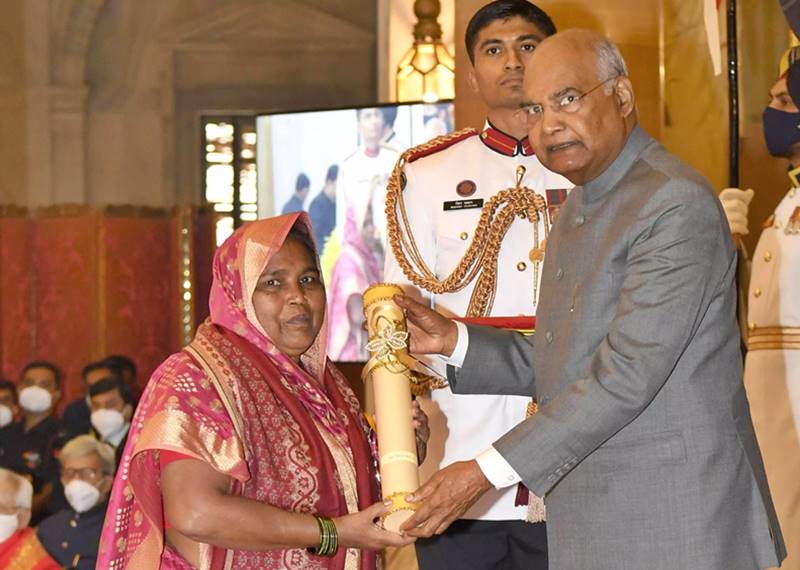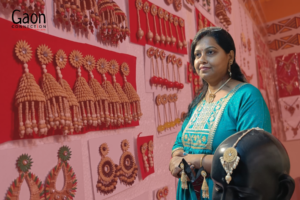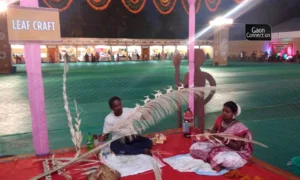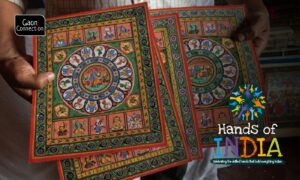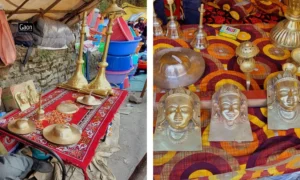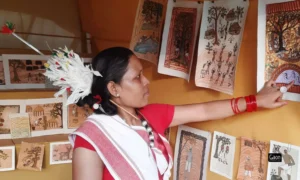Madhubani, Bihar
Today, on November 1, President Ram Nath Kovind conferred 119 eminent personalities with the Padma Awards in a ceremony held at the Rashtrapati Bhawan in New Delhi. Among the recipients was Dulari Devi, a 55-year-old artist from Bihar’s Madhubani district who practices Mithila folk art.
When Dulari Devi’s phone rang on a day before the Republic Day this year, she couldn’t believe her ears. “It was a phone call from Delhi,” is how she remembers the morning when she got the news of her selection for the award.
“I had never expected or imagined that I would ever be given such an honour. I was simply happy painting,” she told Gaon Connection.
Also Read: Life As Art: Madhubani paintings depict how a women’s SHG saved Odisha’s Kanjariguda
The artist belongs to the mallah or the nishad community which is an extremely backward class and is known for its marginalised soci-economic status.
Mithila art and heritage
Dulari Devi is not the only artist from Raanti village in Bihar’s Madhubani who has been awarded with Padma Shri. Her village is known for practising Mithila folk art which is also known as Madhubani art.
Two other artists, 93-year-old Godawari Dutta had received the honour two years back in 2019 while Mahasundari Devi was awarded the Padma Shri in 2011. The latter died in 2013 at the age of 91.
Also Read: Something amiss: Why has rural India gone missing from the Hindi cinema?
Mithila art is popular all over the Madhubani district and involves sensitive drawing of geometrical patterns on a cloth or a canvas using natural dyes, brushes, pens, twigs and match-sticks.
Many artists, mainly women, from the region have won national acclaim for their contributions to the rich folk art.
Married off at 12, called off marriage at 15
Dulari Devi’s life struggles are hard to imagine by looking at the intricate patterns and designs drawn by her using a myriad of hues. Born in a poor household, she never got a chance to access education.
She was married at the age of 12 but her free spirit couldn’t be contained in the shackles of her husband’s oppressive household.
Also Read: The lockdown has exposed the hidden layers of the lives of Madhubani painting artists
“It was difficult for me to tolerate my husband and even my saas (mother-in-law) didn’t want me to live with her. I returned to my parent’s house about two years later and never went back to my husband ever since,” Dulari Devi told Gaon Connection.
“I found it better to work as a labourer with my mother than living in my husband’s house,” she added.
She was born and brought up with glaring poverty and lived in a house made of straw and a thatched roof.
“My mother used to work as a farm labourer to earn a living. When I returned from my husband’s house, I joined my mother at work. But after a while, I began working as a domestic worker in a family,” the artist said.
“That family had many artists who used to practice Madhubani painting. I used to see women painting and yearned to do it myself but life was tough” she remembered.
Also Read: Middlemen robbing Bihar’s Madhubani artisans of recognition and livelihood
The household in which Dulari Devi worked as a maid was home to Mahasundari Devi and Karpoori Dev — two famed artists of the Madhubani art.
Humble beginning — using twig to paint on the floor
Her fascination with painting led her to draw patterns on the floor with a twig. The memory of drawing those figures on the floor are still fresh on the artist’s psyche.
“I didn’t have the money to buy colours or brushes. When I used to return to my home after work, I used to paint on the floor. I used a tehni (twig) to draw patterns on the wet, muddy soil of my ghar’s kachchi zameen (house’s muddy ground),” she recalled.
But the environment around her offered little appreciation for her artistic sensitivity.
“My mother used to scold me for doing it… She had a belief that drawing images on the ground invites poverty,”the artist told Gaon Connection.
During a training session in the house where she was employed to wash utensils, it was for the first time that Dulari Devi held a paint brush.
“A training session was held at the house of Karpuri Devi and Mahasundari Devi. I also participated in it. I had already seen them painting and knew the basics of it. I began painting under their guidance after that session,” she said.
“I was also appointed to help them in preparing the canvas and assist them in arranging the material required to paint. I was paid extra money for it,” Dulari Devi informed.
She is grateful to the two artists who taught her the nuances of painting in the Mithila style.
“They taught me that one should never imitate drawing but use one’s own imagination. It inspired me to experiment with different patterns of my own choice. It was an empowering experience,” she remembered.
Making of an artist
The visit of a renowned artist Gauri Mishra was an important turning point in Dulari Devi’s life. In 1983, Mishra set up an institute to train rural women in Mithila folk art.
It was Karpuri Devi who enrolled the artist at the institute.
“It was my introduction to the Mithila art form in a formal sense. Initially, I was given an expensive-looking shiny fabric to paint on. But I refused to draw on it. Four days later, a cotton cloth was arranged for me and I began drawing on it,” she told Gaon Connection.
“The senior artist liked my painting. Then I was given a sari to paint. I painted on it for two months,” she added.
Gradually, Dulari Devi evolved into a professional artist whose work was in demand.
“Initially, I used to earn five rupees for my painting. If the canvas size was big, I used to earn as much as forty rupees. Whenever Karpuri Devi used to go to Japan, she took along my creations which won accolades abroad,” she added.
In the present day, Dulari Devi’s work has afforded her to get a pucca house constructed.
“I owe my achievements to Karpuri Devi. She helped me a lot. That phone call from Delhi which informed me that I have been chosen for Padma Shri, I owe it to her. Had she been alive, she would have been very happy seeing this,” Dulari Devi told Gaon Connection.
Karpuri Devi was also instrumental in setting up a museum of Maithili folk art in Japan’s Tokamachi city.

